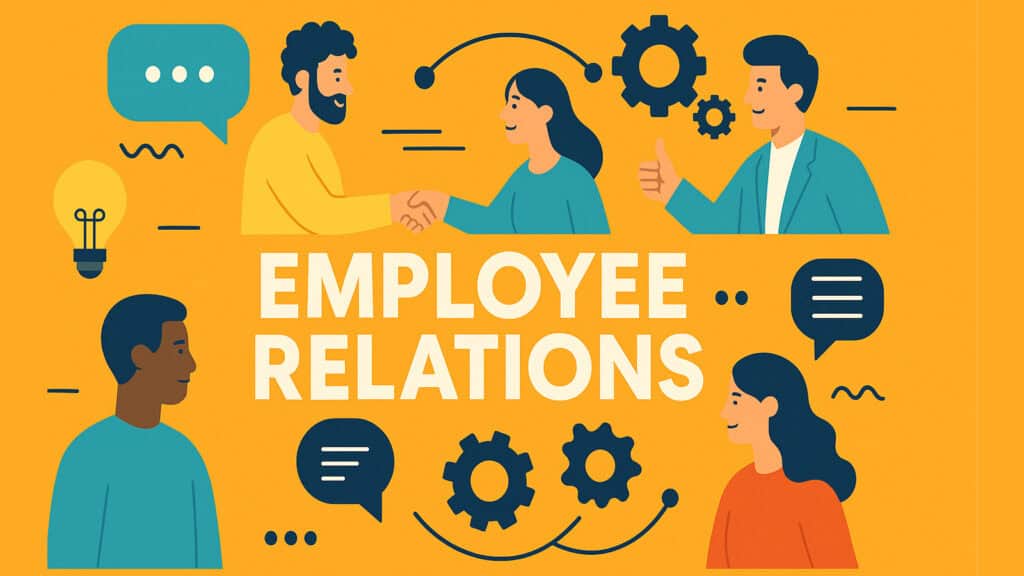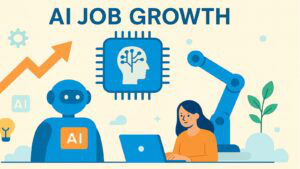Table of Contents
Introduction: Why Employee Relations Matter in a Dehumanized World
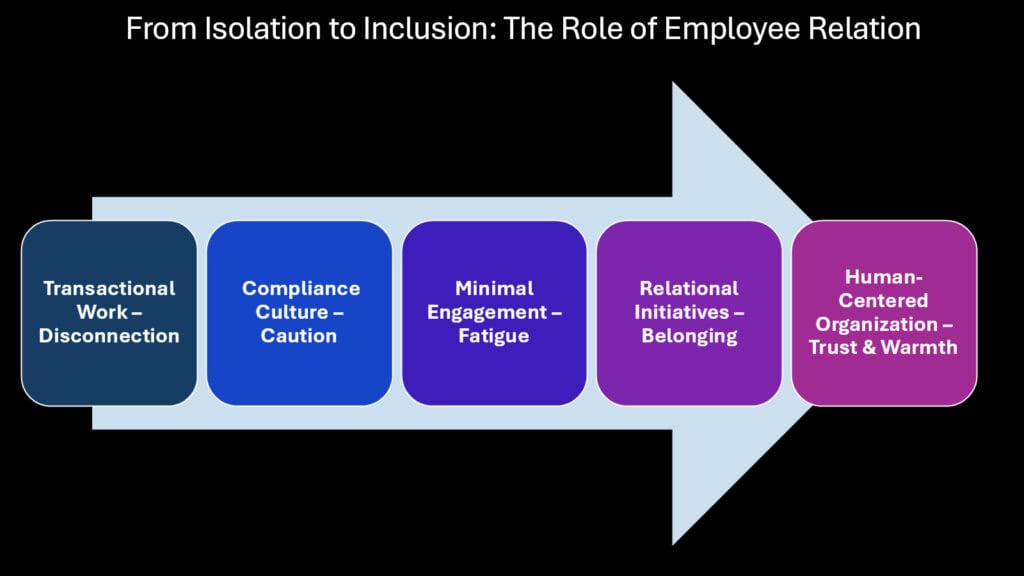
The modern workplace often resembles a mechanical assembly line where human beings become mere cogs in an efficiency machine. Employees clock in, execute tasks, and clock out, disconnected from purpose, colleagues, and their own humanity. This industrial approach to work has created environments where people feel invisible, undervalued, and emotionally detached from their professional lives. The consequences ripple through every corner of business operations, from declining productivity to soaring turnover rates.
Employee Relations emerges as the antidote to this dehumanization crisis. As a critical Human Resources function, Employee Relations focuses on building meaningful connections between organizations and their workforce while fostering positive relationships among team members. Unlike traditional HR processes that often feel transactional, Employee Relations operates as the emotional heartbeat of an organization, ensuring that human dignity and connection remain at the center of workplace culture.
The influence of Employee Relations extends far beyond HR departments. When employees feel valued and connected, marketing teams create more authentic campaigns because they understand their company’s genuine values. Operations run smoother because workers collaborate naturally rather than being forced into artificial cooperation. Sales teams perform better because they believe in what they represent. Finance departments make more strategic decisions because they consider human impact alongside numerical outcomes. This interconnected web demonstrates how Employee Relations serves as the foundation for organizational success.
Research from Gallup consistently shows that organizations with engaged employees experience significantly higher profitability, customer satisfaction, and employee retention. The Harvard Business Review has documented how companies with strong Employee Relations practices outperform their competitors across multiple metrics. These findings underscore that Employee Relations is not a soft skill or nice-to-have function but a strategic business imperative.
The six ways Employee Relations humanize workplaces reveal a comprehensive approach to organizational transformation. These methods work together to create environments where people thrive professionally while maintaining their humanity and personal dignity.
| Key Areas of Employee Relations Impact | Primary Business Function Affected | Humanization Outcome |
|---|---|---|
| Emotional well-being and psychological safety | Operations and productivity | Employees feel secure to innovate and take risks |
| Cultural development and engagement | Marketing and brand authenticity | Teams create genuine connections with customers |
| Trust building and transparency | Finance and strategic planning | Decisions consider human impact alongside profits |
| Leadership development and empathy | Sales and customer service | Representatives approach clients with authentic care |
| Social connection and networking | All departments | Cross-functional collaboration becomes natural |
| Remote work integration | Technology and communication | Digital interactions maintain human warmth |
1. Employee Relations as Emotional Infrastructure
Abraham Maslow’s Hierarchy of Needs provides a compelling framework for understanding how Employee Relations function as emotional infrastructure within organizations. Just as physical infrastructure supports transportation and communication, emotional infrastructure supports human connection and psychological well-being in the workplace. This foundation enables employees to move beyond basic survival mode and reach toward self-actualization in their professional lives.
The physiological and safety needs that form Maslow’s base translate directly into workplace security, fair compensation, and physical well-being. Employee Relations professionals ensure these fundamental requirements are met through comprehensive benefits programs, safe working conditions, and transparent communication about job security. Without this foundation, employees remain anxious and focused on survival rather than growth and contribution.
Love and belonging needs manifest in workplace relationships, team cohesion, and organizational culture. Employee Relations creates systems for meaningful connection through mentorship programs, cross-departmental collaboration initiatives, and social events that build genuine relationships. These connections transform workplaces from collections of individual performers into communities of mutual support and shared purpose.
Esteem needs emerge through recognition programs, career development opportunities, and feedback systems that acknowledge individual contributions. Employee Relations designs recognition frameworks that celebrate both achievement and effort, ensuring that employees feel valued for their unique contributions. This recognition must feel authentic and personalized rather than mechanical or generic.
Self-actualization represents the pinnacle where employees align their personal values with organizational mission and find deep meaning in their work. Employee Relations facilitates this alignment by helping employees understand how their roles contribute to larger organizational goals and societal impact. When people connect their daily tasks to meaningful outcomes, work becomes a source of fulfillment rather than mere obligation.
The psychological safety that emerges from this emotional infrastructure enables innovation, risk-taking, and creative problem-solving. Employees who experience emotional security are more inclined to share their ideas, acknowledge their mistakes, and work together effectively. This safety net becomes particularly crucial during organizational changes, crises, or periods of uncertainty.
| Maslow’s Need Level | Employee Relations Application | Workplace Humanization Impact |
|---|---|---|
| Physiological | Comprehensive benefits and work-life balance | Employees focus on growth rather than survival |
| Safety | Job security communication and fair policies | Psychological safety enables risk-taking and innovation |
| Love and Belonging | Team building and mentorship programs | Genuine workplace relationships and community feeling |
| Esteem | Recognition systems and career development | Individual dignity and professional growth |
| Self-Actualization | Purpose alignment and meaningful work | Deep engagement and personal fulfillment |
2. Employee Relations Builds Cultures of Everyday Dignity
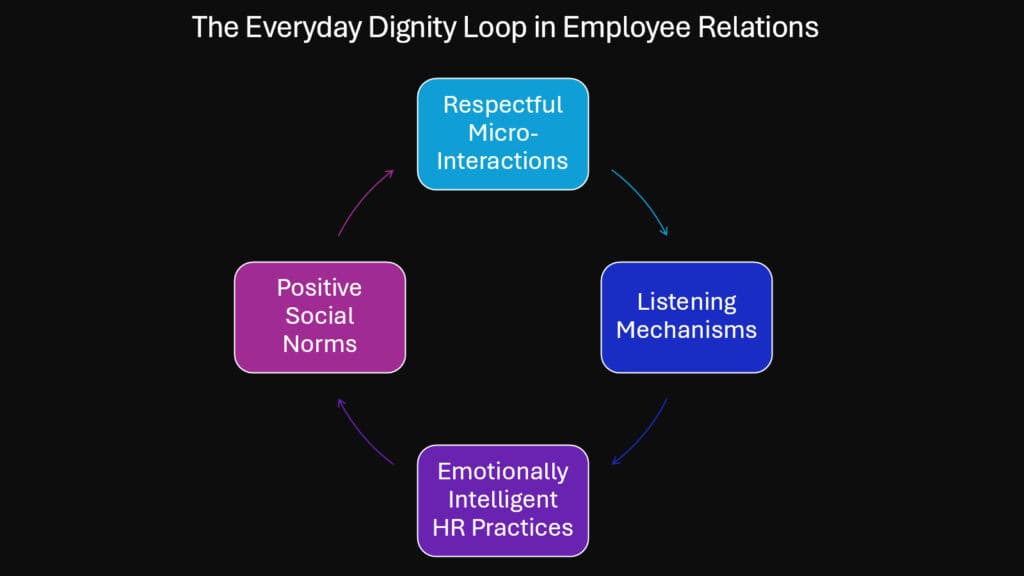
Employee Relations transforms organizational culture by embedding dignity into daily interactions and operational procedures. This cultural shift moves beyond policy compliance toward creating environments where respect becomes the default mode of engagement. The impact reaches every HR function, creating synergies that amplify the effectiveness of recruitment, training, and development initiatives.
Recruitment benefits enormously from strong Employee Relations culture. When current employees feel valued and respected, they become authentic brand ambassadors who attract high-quality candidates. The recruitment process itself becomes more humane, focusing on cultural fit and mutual respect rather than purely transactional exchanges. Candidates experience the organization’s values firsthand during interviews, creating positive impressions that extend beyond the hiring decision.
Training programs gain deeper effectiveness when delivered within a culture of dignity. Employees engage more fully in learning opportunities when they feel their growth is genuinely valued rather than merely required. Employee Relations ensures that training addresses not just technical skills but also interpersonal competencies that support respectful workplace interactions. This comprehensive approach creates learning environments where people feel safe to make mistakes and ask questions.
Employee development flourishes in cultures where dignity is prioritized. Career advancement becomes transparent and merit-based rather than political or arbitrary. Employee Relations advocates for fair promotion processes and creates pathways for growth that respect individual circumstances and aspirations. This approach reduces turnover because employees see genuine opportunities for advancement within their current organization.
The everyday dignity that Employee Relations promotes manifests in small but significant gestures. Managers who remember personal details about team members, policies that accommodate individual needs, and communication that treats employees as whole people rather than just workers. These seemingly minor elements accumulate into powerful cultural forces that shape how people experience their work environment.
Employee engagement increases measurably when dignity becomes embedded in organizational culture. Employees who are engaged exhibit increased levels of productivity, creativity, and loyalty. They contribute discretionary effort because they feel emotionally invested in organizational success. This engagement translates into better customer service, higher quality output, and stronger financial performance.
Attrition rates decline significantly in organizations that prioritize dignity through Employee Relations. People leave jobs primarily because they feel undervalued or disrespected, not because of compensation or benefits. When employees feel seen and appreciated as individuals, they develop stronger connections to their roles and organizations. This retention saves substantial costs associated with recruitment, training, and lost productivity.
| Dignity-Building Practice | HR Function Impact | Engagement Outcome |
|---|---|---|
| Personalized recognition programs | Recruitment attracts values-aligned candidates | Employees feel individually valued and appreciated |
| Transparent career development paths | Training becomes more meaningful and effective | Clear growth opportunities increase retention |
| Flexible work arrangements | Development programs accommodate individual needs | Work-life integration improves satisfaction |
| Regular feedback and listening sessions | All HR functions become more employee-centric | Continuous improvement strengthens relationships |
| Inclusive decision-making processes | Policies reflect diverse employee perspectives | Shared ownership increases commitment |
3. Employee Relations as a Trust Dividend
Stephen Covey’s Speed of Trust Model illuminates how Employee Relations function as trust multipliers within organizations. Trust operates like a dividend that compounds over time, creating exponential returns in collaboration, efficiency, and performance. When employees trust their colleagues, managers, and organizational systems, work flows more smoothly and achieves better outcomes with less friction and oversight.
The first component of Covey’s model focuses on self-trust, which Employee Relations supports through career development, skill building, and confidence-building initiatives. When employees trust their own capabilities and feel supported in their growth, they approach challenges with greater resilience and creativity. This self-trust translates into willingness to take on new responsibilities and contribute innovative ideas.
Relationship trust emerges through consistent, respectful interactions that Employee Relations facilitates. Trust between colleagues develops when people feel safe to be vulnerable, share ideas, and admit mistakes without fear of judgment or retaliation. Employee Relations creates frameworks for healthy conflict resolution and communication that builds rather than erodes trust over time.
Organizational trust requires systems, processes, and leadership behaviors that demonstrate reliability and integrity. Employee Relations ensures that policies are fair, consistently applied, and clearly communicated. When employees trust that their organization will treat them fairly and honor its commitments, they reciprocate with loyalty and discretionary effort.
Market trust extends organizational trust to external relationships with customers, suppliers, and stakeholders. Organizations with strong internal trust cultures tend to build more authentic external relationships because their employees genuinely believe in and represent their company’s values. This authenticity creates competitive advantages in customer retention and brand reputation.
Societal trust represents the highest level where organizations earn respect and legitimacy within their broader communities. Companies known for treating employees well attract better talent, customers, and business partners. This reputation becomes a valuable asset that supports long-term sustainability and growth.
The speed of trust that Covey describes becomes particularly evident during crises or major organizational changes. Organizations with strong Employee Relations recover more quickly from setbacks because their foundation of trust enables rapid decision-making and collective action. Employees extend trust to leadership during uncertain times, reducing resistance and accelerating adaptation.
High-trust environments created through Employee Relations reduce the need for extensive oversight, detailed procedures, and micromanagement. Teams operate more efficiently because they trust each other to fulfill commitments and maintain quality standards. This efficiency translates into cost savings and improved performance across all business functions.
| Trust Level | Employee Relations Application | Speed of Trust Impact |
|---|---|---|
| Self-Trust | Individual development and skill building | Employees approach challenges with confidence |
| Relationship Trust | Conflict resolution and communication training | Teams collaborate more effectively |
| Organizational Trust | Fair policies and transparent leadership | Reduced friction in daily operations |
| Market Trust | Employee advocacy and authentic representation | Stronger external relationships |
| Societal Trust | Ethical practices and community engagement | Enhanced organizational reputation |
4. Employee Relations Redefine Authority and Leadership Through Empathy
Employee Relations transforms traditional command-and-control leadership models by introducing empathy as a core competency for organizational authority. This shift represents a fundamental reimagining of how power operates within business structures, moving from hierarchical dominance toward collaborative influence. The result is leadership that inspires rather than intimidates, creating environments where human potential flourishes.
Empathetic leadership begins with the recognition that every employee brings unique perspectives, experiences, and challenges to their work. Employee Relations trains leaders to understand these individual differences and adapt their management approach accordingly. This personalized leadership style acknowledges that effective management requires emotional intelligence alongside technical competence.
The development of empathetic leadership skills requires systematic training and support. Employee Relations creates programs that teach leaders to recognize emotional cues, practice active listening, and respond appropriately to employee needs. These skills enable leaders to build stronger relationships with their teams and create psychological safety that encourages innovation and risk-taking.
Authority redefined through empathy operates through influence rather than coercion. Leaders who show authentic concern for the well-being and development of their employees gain respect and loyalty that cannot be demanded through formal authority structures. This earned authority proves more sustainable and effective than traditional hierarchical control.
Employee Relations facilitates the transition from transactional to transformational leadership by providing tools and frameworks for meaningful employee engagement. Leaders learn to connect individual roles to organizational purpose, helping employees understand how their contributions matter. This connection transforms work from mere task completion to meaningful contribution.
The ripple effects of empathetic leadership extend throughout organizational culture. When employees receive empathy from their managers, they are more inclined to show empathy towards their colleagues and customers. This creates a positive feedback loop that strengthens relationships at every level of the organization.
Global economies increasingly recognize the value of empathetic leadership in driving business results. Research from various international business schools demonstrates that empathetic leaders achieve better financial performance, higher employee engagement, and stronger customer relationships. This evidence supports the business case for investing in Employee Relations programs that develop empathetic leadership capabilities.
Organizations that successfully implement empathetic leadership through Employee Relations report improved innovation, reduced turnover, and enhanced reputation. These outcomes result from creating environments where employees feel valued, understood, and empowered to contribute their best work.
| Leadership Transformation Area | Traditional Approach | Empathetic Leadership Through Employee Relations |
|---|---|---|
| Decision Making | Top-down directives with limited input | Collaborative processes that consider employee perspectives |
| Performance Management | Focus on metrics and compliance | Holistic view of employee development and well-being |
| Communication Style | Formal, hierarchical information flow | Open, transparent dialogue with active listening |
| Conflict Resolution | Authoritarian rulings and enforcement | Mediation and mutual understanding approaches |
| Employee Development | Standardized training programs | Personalized growth plans based on individual needs |
| Recognition and Feedback | Annual reviews and formal evaluations | Continuous feedback and meaningful recognition |
5. Employee Relations as Social Capital Builders
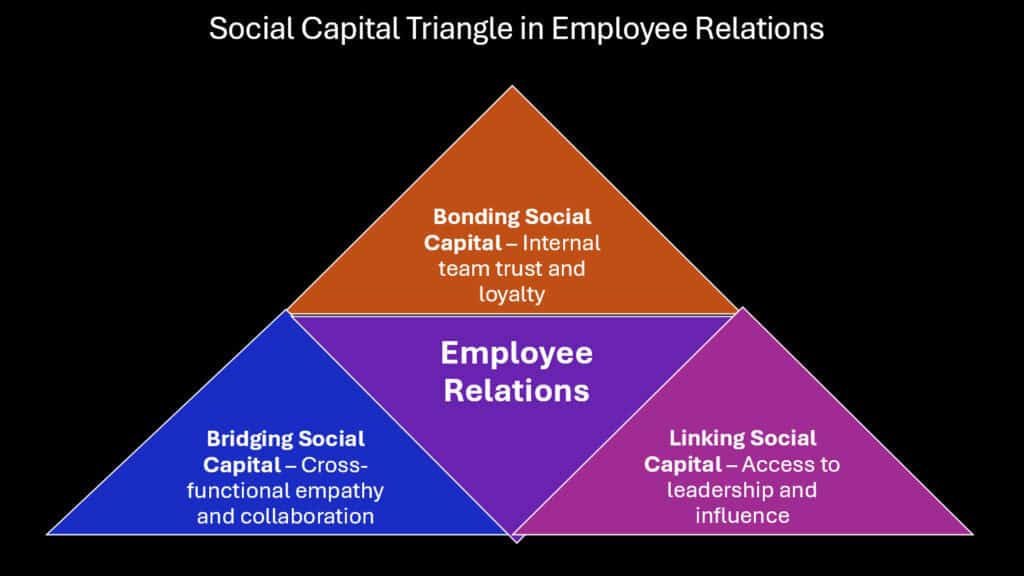
Pierre Bourdieu’s Theory of Social Capital provides a lens for understanding how Employee Relations create and preserve valuable networks of relationships within organizations. Social capital represents the accumulated goodwill, trust, and reciprocity that exists between people, forming an invisible asset that enhances organizational effectiveness. Employee Relations systematically builds this capital through intentional relationship-building initiatives and cultural practices.
The formation of social capital requires deliberate investment in relationship-building activities. Employee Relations designs programs that bring employees together across departments, levels, and functions to create meaningful connections. These interactions must move beyond surface-level networking to develop genuine understanding and mutual respect between colleagues.
Reciprocity forms the foundation of social capital, where employees feel comfortable asking for help and offering assistance to others. Employee Relations creates systems that facilitate knowledge sharing, mentorship, and collaborative problem-solving. When employees know they can rely on colleagues for support, they are more willing to contribute their own expertise and resources.
The emotional goodwill that accumulates through positive workplace relationships becomes a reservoir that organizations can draw upon during challenging times. Employees who feel connected to their colleagues are more likely to extend extra effort during busy periods, support organizational changes, and maintain morale during difficult situations.
Internal networks facilitated by Employee Relations break down silos and improve information flow throughout organizations. When employees have relationships across different departments, they can access expertise and resources more efficiently. This connectivity accelerates problem-solving and innovation by enabling rapid knowledge transfer.
The preservation of social capital requires ongoing attention and investment. Employee Relations monitors relationship health through surveys, feedback sessions, and observation of collaboration patterns. When social capital begins to erode, interventions can restore trust and connection before relationships become damaged beyond repair.
Different economic contexts value social capital differently, but its importance transcends cultural boundaries. In relationship-oriented economies like Japan, social capital aligns with cultural values of harmony and group cohesion. In individualistic economies like the United States, social capital provides competitive advantages through network effects and collaboration. European economies often balance individual achievement with collective success, making social capital essential for organizational effectiveness.
The measurement of social capital presents challenges, but its effects are visible in organizational performance metrics. Companies with strong social capital demonstrate higher employee engagement, faster innovation cycles, and better crisis response capabilities. These outcomes justify the investment in Employee Relations programs that build and maintain social capital.
| Social Capital Component | Employee Relations Application | Organizational Benefit |
|---|---|---|
| Network Density | Cross-functional teams and collaboration projects | Improved information flow and knowledge sharing |
| Relationship Quality | Mentorship programs and team building activities | Higher trust and mutual support |
| Reciprocity Norms | Knowledge sharing platforms and peer assistance | Increased willingness to help colleagues |
| Shared Values | Culture development and values alignment | Stronger organizational identity and cohesion |
| Collective Efficacy | Group problem-solving and joint achievements | Enhanced team performance and innovation |
6. Employee Relations Anchor Hybrid Work in Humanity
The shift toward hybrid and remote work arrangements has created new challenges for maintaining human connection and organizational culture. Employee Relations plays a crucial role in ensuring that flexible work arrangements preserve the humanity that makes work meaningful while avoiding the isolation and disconnection that can plague distributed teams.
Emotional connection in hybrid environments requires intentional design and ongoing cultivation. Employee Relations creates structured opportunities for meaningful interaction that go beyond task-focused meetings. These might include virtual coffee chats, online team-building activities, and digital spaces for casual conversation that replicate the spontaneous interactions of traditional office environments.
Fairness in hybrid arrangements becomes a critical concern when some employees work remotely while others remain in physical offices. Employee Relations develops policies and practices that ensure equal access to opportunities, information, and recognition regardless of work location. This fairness extends to career advancement, project assignments, and social inclusion.
The sense of shared presence that Employee Relations facilitates helps remote and hybrid teams maintain cohesion and collective identity. This involves creating digital rituals, shared experiences, and common references that bind team members together despite physical separation. Regular all-hands meetings, virtual celebrations, and collaborative projects help maintain organizational culture across distributed teams.
Technology becomes a tool for humanization rather than dehumanization when guided by Employee Relations principles. The focus shifts from efficiency and surveillance to connection and support. Communication platforms are designed to facilitate relationship-building alongside task completion, with features that support both professional and personal interaction.
Work-life integration in hybrid environments requires careful attention to boundaries and employee well-being. Employee Relations helps establish norms around communication timing, meeting schedules, and availability expectations that respect individual circumstances and preferences. This flexibility acknowledges that employees have different personal situations and working styles.
The measurement of engagement and satisfaction in hybrid environments requires new approaches and metrics. Employee Relations develops assessment tools that capture the unique challenges and opportunities of distributed work. Regular pulse surveys, one-on-one check-ins, and feedback mechanisms help identify issues before they become problems.
Future trends in hybrid work will likely emphasize the human elements that Employee Relations champions. As organizations gain experience with distributed teams, the importance of connection, culture, and well-being becomes increasingly apparent. Employee Relations positions organizations to thrive in this evolving landscape by maintaining focus on human needs alongside business objectives.
| Hybrid Work Challenge | Employee Relations Solution | Humanization Outcome |
|---|---|---|
| Isolation and disconnection | Structured social interaction and virtual community building | Maintained relationships and sense of belonging |
| Communication barriers | Multiple channels and communication training | Clear, empathetic information sharing |
| Unequal treatment | Fair policies and inclusive practices | Equal opportunities regardless of location |
| Cultural dilution | Intentional culture reinforcement and shared experiences | Strong organizational identity and values |
| Work-life boundary issues | Flexible guidelines and individual accommodation | Healthy integration and personal well-being |
| Performance monitoring | Trust-based management and outcome focus | Autonomy and professional growth |
Conclusion: The Quiet Power of Employee Relations in Building Humane Organizations
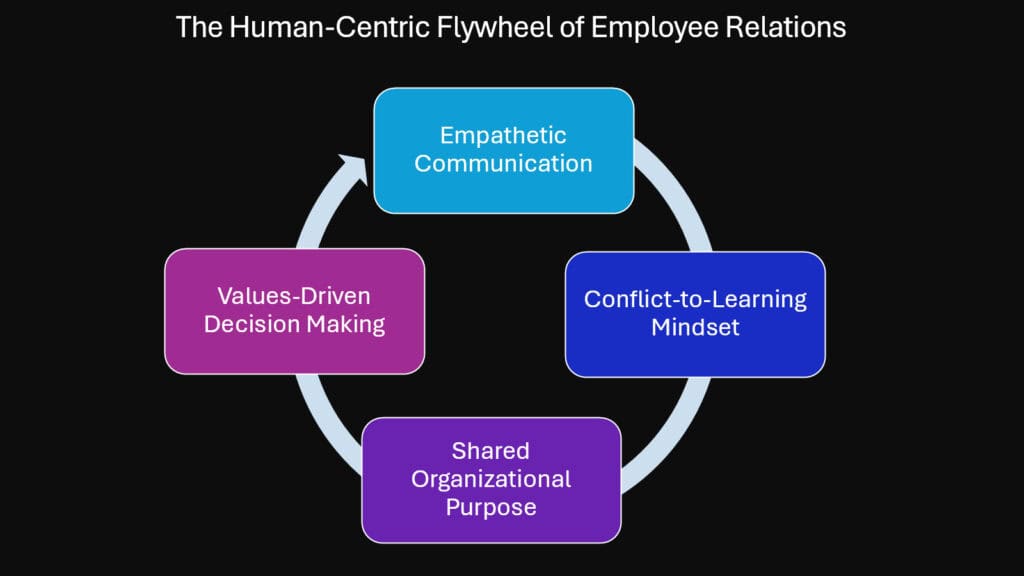
Employee Relations operates as a quiet but powerful force that transforms organizations from mechanical systems into human communities. Unlike dramatic restructuring or technological implementations, Employee Relations creates change through consistent, respectful attention to human needs and relationships. This steady approach builds sustainable cultures that endure through leadership changes, economic fluctuations, and industry disruptions.
The proactive nature of Employee Relations distinguishes it from reactive HR functions that respond to problems after they occur. Instead of waiting for conflicts to escalate or engagement to decline, Employee Relations anticipates human needs and creates systems that prevent issues while nurturing positive relationships. This preventive approach proves more effective and less costly than addressing problems after they develop.
The cultural engine that Employee Relations represents operates continuously, generating energy and momentum that propel organizations toward their goals. This engine runs on human connection, mutual respect, and shared purpose rather than fear, competition, or external pressure. The result is sustainable performance that maintains effectiveness over time while preserving employee well-being and satisfaction.
Organizations that embrace Employee Relations as a strategic function rather than an administrative task gain competitive advantages that compound over time. These advantages include higher employee retention, stronger customer relationships, better innovation capabilities, and enhanced reputation. The return on investment in Employee Relations becomes apparent through improved performance across all business functions.
The kindness that Employee Relations brings to organizations should not be mistaken for weakness or sentimentality. Instead, it represents a sophisticated understanding of human motivation and organizational effectiveness. Kind organizations attract better talent, generate more loyalty, and achieve superior results because they align with fundamental human needs for respect, connection, and purpose.
The intelligence that emerges from Employee Relations comes from recognizing that human beings are complex, capable, and valuable assets who require different management approaches than physical or financial resources. This intelligence guides organizations toward practices that unlock human potential rather than merely extracting compliance or productivity.
The future of work increasingly depends on organizations’ ability to remain human in an increasingly digital and automated world. Employee Relations provides the foundation for this humanity by ensuring that technology serves human needs rather than replacing human connection. As artificial intelligence and automation handle routine tasks, the human elements of work become more valuable and necessary.
| Employee Relations Impact Area | Traditional HR Approach | Humanizing Employee Relations Approach |
|---|---|---|
| Organizational Culture | Policy enforcement and compliance | Relationship building and value alignment |
| Employee Engagement | Survey administration and metric tracking | Continuous dialogue and meaningful connection |
| Performance Management | Evaluation and rating systems | Development and growth support |
| Conflict Resolution | Disciplinary procedures and rule enforcement | Mediation and understanding facilitation |
| Change Management | Communication and training programs | Emotional support and collaborative adaptation |
| Leadership Development | Skills training and competency building | Empathy cultivation and relationship intelligence |
The quiet power of Employee Relations lies in its ability to transform organizations without fanfare or disruption. Through consistent attention to human dignity, relationship quality, and cultural development, Employee Relations creates environments where people thrive professionally while maintaining their humanity. This transformation benefits not only employees but also customers, shareholders, and society as a whole, creating value that extends far beyond traditional business metrics.

